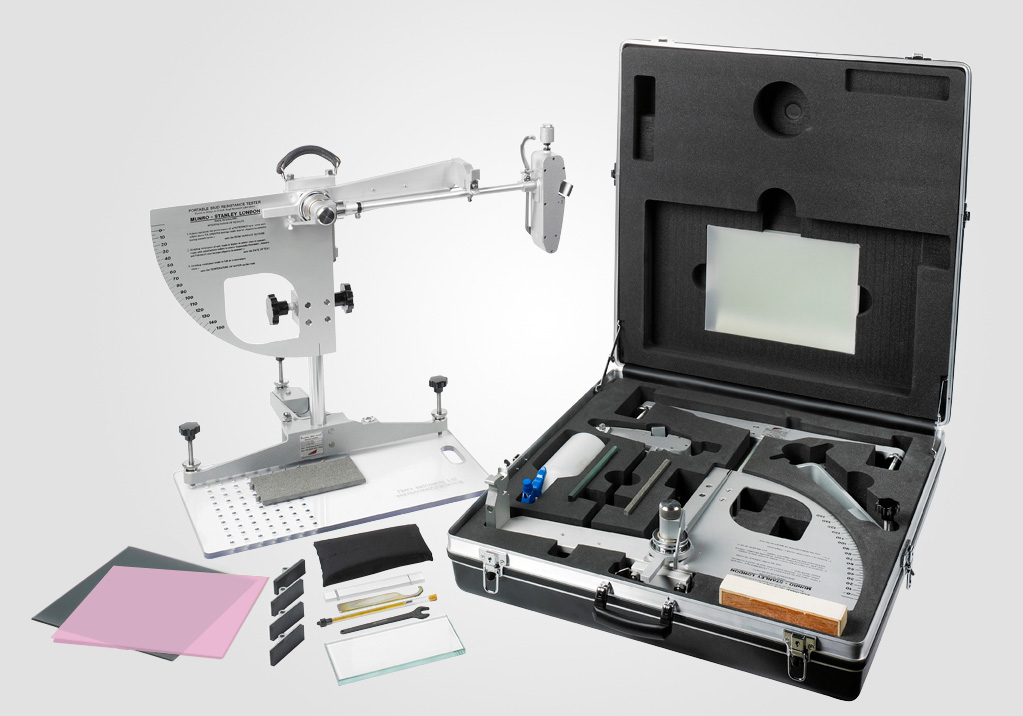The BS 7976 Pendulum

In wide use in the UK, the Pendulum is a well developed test method that is capable of producing reliable, accurate, repeatable and reproducible results when operated correctly. Results from the Pendulum can be interpreted to give an indication of the likelihood of a person slipping in a given scenario.
The Pendulum can be operated to a wide range of UK, European and International standards. British Standard BS 7976 (soon to be superseded by BS EN 16165) describes its specification, operation and calibration. The UK Slip Resistance Group Guidelines have been developed collaboratively by members with 100’s of years of experience in the field of slips, and these guidelines improve on the groundwork laid by the British Standard. Several members of the UKSRG are active members of various British and European standards committees. The UK Regulator (the Health and Safety Executive) are members of the Group and made a significant contribution to the current Guidelines, and consequently the Pendulum test to UKSRG Guidelines is the preferred slip test method of the HSE. It follows then that the UK legal system relies on the preferred method of the UK regulator, and Pendulum test results are used widely in personal injury litigation.
The Pendulum test works by swinging a prepared rubber slider on a mechanical foot across a surface. The foot contacts the surface across a set distance, in a controlled manner and slows according to the level of slip resistance. The Pendulum Test Value is measured on the scale accordingly. The standard test is conducted in the dry and with water contamination, and crucially because the ‘foot’ moves across the surface in a similar manner to a pedestrian’s heel in a slip, it produces the same hydraulic uplift effect that a pedestrian would experience on a wet floor. The Pendulum Test Value is then interpreted, in conjunction with the Slips Potential Model, to determine whether the tested floor is safe or slippery.
The Pendulum has several key benefits as a slip resistance test;
- The science is good. The machine interacts with the surface in a similar way to a pedestrian’s foot in a real slip. The test can be used with a wide range of contaminants found in different environments, including but not limited to sawdust, grease, custard powder, cream, etc. The test requires strict adherence to a controlled method of manufacture, calibration, verification and testing, and when operated correctly a group conducting round robin testing can (and do) produce tightly grouped data points. The test methodology is constantly being developed by the UKSRG.
- The machine is portable. Tests can be conducted in situ, in the same location and conditions that pedestrians experience. Tests can be used to proactively assess risk, gather information and identify control measures, investigate accidents and evaluate cleaning regimes. The test is also used, and accepted, in personal injury litigation. It is important to understand how the installed floor will behave and this may require both ex-factory and in-situ PTV’s. The portability of the Pendulum allows an insight into the performance of a surface in end-use, how local contaminants affect grip, and whether cleaning is effective.
- A robust verification process has been developed by the UKSRG. Verification requires measurement of three surfaces of known slip resistance covering the important range of operation. The verification process is a check that the calibrated machine and the operator are performing correctly immediately prior to testing. Only when the machine produces acceptable values (within a narrow range) on the control surfaces should the material test go ahead. This verification process has been developed, refined and used successfully for over ten years. This ensures a high level of confidence in the results produced.
- There is a significant volume of data tying Pendulum Test Values (PTV’s) to slip accidents. Historic studies predict the likelihood of a slip occurring at a given PTV, whilst regulator-produced PTV’s show correlation with real slip accidents. It is very powerful to be able to state that a floor has a PTV of 20, which means a related high risk of slipping, and in turn an associated legal liability (in the UK).
Whilst there is a wide range of slip test methods available and in use, the Pendulum test is the only slip resistance test recommended by the UKSRG and HSE.
The UKSRG Guidelines which form the basis of the regulators preferred Pendulum methodology are currently in their 5thiteration with the 6th version penned for release soon. The UKSRG Guidelines provide more detailed advice on operation of the pendulum, including dealing with more difficult test scenarios such as testing on stairs, slopes, and heavily profiled surfaces. The Guidelines are subject to constant review from all members of the Group which include a wide range of manufacturers, testers, consultants, research organisations, cleaning, flooring and anti-slip companies, alongside the HSE. Guidelines produced by the group are informed by feedback from the slip resistance community, and benefit from robust research and experience from the same.
The Guidelines have so far seen improvements to the testing process to include a more robust verification procedure, introduction of a new verification surface, development of improved slider preparation measures, and a wealth of advice and guidance both on operation of the machine and interpretation of the results. A copy of the Guidelines is essential reading for any test operator, regardless of experience, interested in producing the most reliable measure of slip resistance. Indeed, the Group welcomes all with an interest in slips and slip resistance to participate in their activities. See UKSRG.com for more information
Published 02/02/2022 BP
Updated 18/10/2023 representing the fact that the green lapping film is not part of the calibration process anymore (photo)
Become a member and get involved in the UK Slip Resistance Group
More